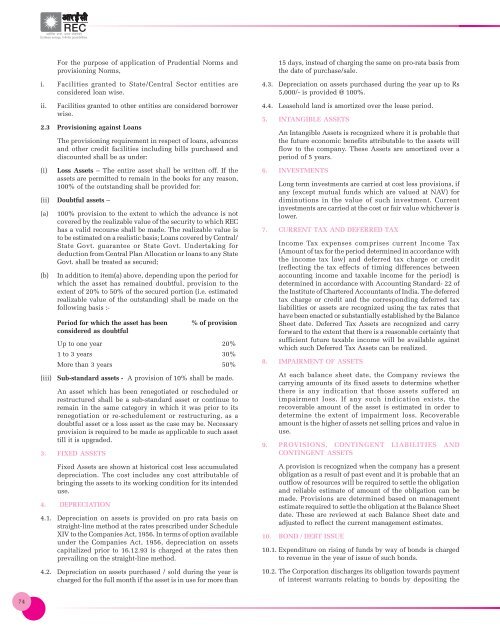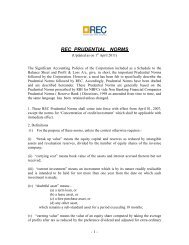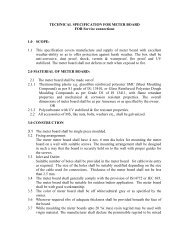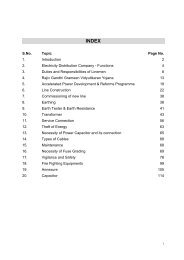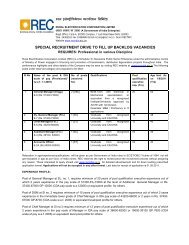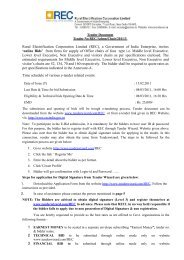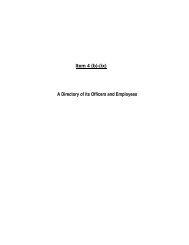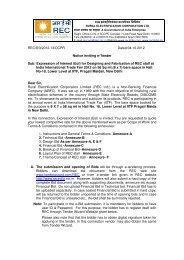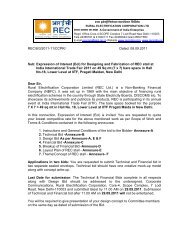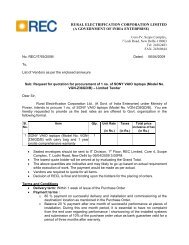REC- 1-51.p65 - Rural Electrification Corporation Ltd.
REC- 1-51.p65 - Rural Electrification Corporation Ltd.
REC- 1-51.p65 - Rural Electrification Corporation Ltd.
Create successful ePaper yourself
Turn your PDF publications into a flip-book with our unique Google optimized e-Paper software.
74<br />
For the purpose of application of Prudential Norms and<br />
provisioning Norms,<br />
i. Facilities granted to State/Central Sector entities are<br />
considered loan wise.<br />
ii. Facilities granted to other entities are considered borrower<br />
wise.<br />
2.3 Provisioning against Loans<br />
The provisioning requirement in respect of loans, advances<br />
and other credit facilities including bills purchased and<br />
discounted shall be as under:<br />
(i) Loss Assets – The entire asset shall be written off. If the<br />
assets are permitted to remain in the books for any reason,<br />
100% of the outstanding shall be provided for:<br />
(ii) Doubtful assets –<br />
(a) 100% provision to the extent to which the advance is not<br />
covered by the realizable value of the security to which <strong>REC</strong><br />
has a valid recourse shall be made. The realizable value is<br />
to be estimated on a realistic basis; Loans covered by Central/<br />
State Govt. guarantee or State Govt. Undertaking for<br />
deduction from Central Plan Allocation or loans to any State<br />
Govt. shall be treated as secured;<br />
(b) In addition to item(a) above, depending upon the period for<br />
which the asset has remained doubtful, provision to the<br />
extent of 20% to 50% of the secured portion (i.e. estimated<br />
realizable value of the outstanding) shall be made on the<br />
following basis :-<br />
Period for which the asset has been<br />
considered as doubtful<br />
% of provision<br />
Up to one year 20%<br />
1 to 3 years 30%<br />
More than 3 years 50%<br />
(iii) Sub-standard assets - A provision of 10% shall be made.<br />
An asset which has been renegotiated or rescheduled or<br />
restructured shall be a sub-standard asset or continue to<br />
remain in the same category in which it was prior to its<br />
renegotiation or re-schedulement or restructuring, as a<br />
doubtful asset or a loss asset as the case may be. Necessary<br />
provision is required to be made as applicable to such asset<br />
till it is upgraded.<br />
3. FIXED ASSETS<br />
Fixed Assets are shown at historical cost less accumulated<br />
depreciation. The cost includes any cost attributable of<br />
bringing the assets to its working condition for its intended<br />
use.<br />
4. DEP<strong>REC</strong>IATION<br />
4.1. Depreciation on assets is provided on pro rata basis on<br />
straight-line method at the rates prescribed under Schedule<br />
XIV to the Companies Act, 1956. In terms of option available<br />
under the Companies Act, 1956, depreciation on assets<br />
capitalized prior to 16.12.93 is charged at the rates then<br />
prevailing on the straight-line method.<br />
4.2. Depreciation on assets purchased / sold during the year is<br />
charged for the full month if the asset is in use for more than<br />
15 days, instead of charging the same on pro-rata basis from<br />
the date of purchase/sale.<br />
4.3. Depreciation on assets purchased during the year up to Rs<br />
5,000/- is provided @ 100%.<br />
4.4. Leasehold land is amortized over the lease period.<br />
5. INTANGIBLE ASSETS<br />
An Intangible Assets is recognized where it is probable that<br />
the future economic benefits attributable to the assets will<br />
flow to the company. These Assets are amortized over a<br />
period of 5 years.<br />
6. INVESTMENTS<br />
Long term investments are carried at cost less provisions, if<br />
any (except mutual funds which are valued at NAV) for<br />
diminutions in the value of such investment. Current<br />
investments are carried at the cost or fair value whichever is<br />
lower.<br />
7. CURRENT TAX AND DEFERRED TAX<br />
Income Tax expenses comprises current Income Tax<br />
(Amount of tax for the period determined in accordance with<br />
the income tax law) and deferred tax charge or credit<br />
(reflecting the tax effects of timing differences between<br />
accounting income and taxable income for the period) is<br />
determined in accordance with Accounting Standard- 22 of<br />
the Institute of Chartered Accountants of India. The deferred<br />
tax charge or credit and the corresponding deferred tax<br />
liabilities or assets are recognized using the tax rates that<br />
have been enacted or substantially established by the Balance<br />
Sheet date. Deferred Tax Assets are recognized and carry<br />
forward to the extent that there is a reasonable certainty that<br />
sufficient future taxable income will be available against<br />
which such Deferred Tax Assets can be realized.<br />
8. IMPAIRMENT OF ASSETS<br />
At each balance sheet date, the Company reviews the<br />
carrying amounts of its fixed assets to determine whether<br />
there is any indication that those assets suffered an<br />
impairment loss. If any such indication exists, the<br />
recoverable amount of the asset is estimated in order to<br />
determine the extent of impairment loss. Recoverable<br />
amount is the higher of assets net selling prices and value in<br />
use.<br />
9. PROVISIONS, CONTINGENT LIABILITIES AND<br />
CONTINGENT ASSETS<br />
A provision is recognized when the company has a present<br />
obligation as a result of past event and it is probable that an<br />
outflow of resources will be required to settle the obligation<br />
and reliable estimate of amount of the obligation can be<br />
made. Provisions are determined based on management<br />
estimate required to settle the obligation at the Balance Sheet<br />
date. These are reviewed at each Balance Sheet date and<br />
adjusted to reflect the current management estimates.<br />
10. BOND / DEBT ISSUE<br />
10.1. Expenditure on rising of funds by way of bonds is charged<br />
to revenue in the year of issue of such bonds.<br />
10.2. The <strong>Corporation</strong> discharges its obligation towards payment<br />
of interest warrants relating to bonds by depositing the


